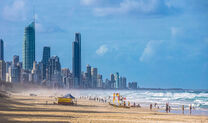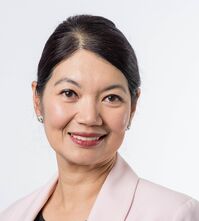Liberté, égalité, fraternité | ||||||||
| Capital (and largest city) |
Louisbourg | |||||||
| Language Official |
French | |||||||
| Others | Various Aboriginal dialects | |||||||
| Religion | 94.7% Christian -61.9% Catholic -27.3% Protestant -5.5% Other Christian 5.3% Other/none | |||||||
| Ethnic Group | 62.8% French 20.2% Asian 10.5% Dutch/New Hollander 4.7% Aboriginal 1.8% other | |||||||
| Demonym | French Australian | |||||||
| Legislature | Departmental council | |||||||
| Prefect | Thierry Queffelec | |||||||
| Area | 93,693 km² | |||||||
| Population | 5,328,102 | |||||||
| Currency | Franc | |||||||
French Australia is an overseas department/region and single territorial collectivity of France located on the Northeastern shore of the Australian continent. French Australia is the second largest region of France behind Nouvelle-Aquitaine. Founded in the 1840s as a French protectorate and eventual French colony, French Australia would develop into a massive trade and tourist hub during the 20th century.
History[]
Pre-Colonial History[]
19th Century[]
French Arrival + Protectorate Status[]
Prior to French arrival, the area in what would become French Australia was claimed by the British as part of Melanesia but remained uninhabited by British settlers and was scarcely populated by Aboriginals. French traders and merchants would create settlements in order to have closer trading outposts to New Holland. Given the large French prescence, the French took over the region in 1842 and established a French protectorate that they called 'Établissements français d'Océanie (EFO)' (French Establishments/Settlements of Oceania) which consisted of French Australia, French Polynesia, and New Caledonia. The settlement of Louisbourg would be founded in 1845, named for Louis XVI, the King of France at the time during the Orleanist Restoration Monarchy.
The city of Louisbourg grew rapidly as French influence in the South pacific and east Asia also grew. By the late 1860s, there were over 50,000 French settlers in the protectorate. This influx of settlers would force the Aboriginal peoples off of the coast and into the outback as conflict between the French and Aboriginals turned violent. In the 1870s this number would only grow larger as many French citizens from the mainland fled to French Australia to avoid the political unrest caused by the French defeat in the Franco-Prussian war and subsequent Paris Commune uprisings.
Conflict with the British + Treaty of Louisbourg[]
With the establishment of the protectorate in what Britain claimed as their land, border skirmishes would arise between the land claimed by the French and what the British claimed as part of Melanesia. This conflict would last throughout the mid-1800s and would be resolved in 1890 when Britain ceded the land of French Australia in exchange for France ceding New Caledonia to British Melanesia. This would become known as the Treaty of Louisbourg and was ratified by both French and British diplomats on June 6th, 1890. Shortly after the treaty was ratified, French Australia would be upgraded from a protectorate to an official overseas territory of France.
20th Century[]
Pre-Great War Growth[]
With French Australia becoming a proper overseas territory, the territory's population growth would explode in the early 20th century. From 1890 to 1910, French Australia's population surpassed 2 million and Louisbourg began to experience urban sprawl with subsequent suburban communities being formed around Loiusbourg. Growth was largely driven by the discovery of the minerals such as iron in the hills of the territory's countryside and new trade routes being established through Louisbourg, linking France and the territory to the economy of the South Pacific. This rapid growth would come to a hault with the outbreak of the Great War which also spread to the Australian continent and south pacific.
Australian Front of the Great War[]
French Australia would see action during the Great War with the port of Louisbourg holding several ships for the French royal navy. French Australia would be used as a staging ground for French naval offenses on German New Guinea, Sofiahafen, and other German pacific possessions. From 1914 to 1919, over 40 ships would pass through the port of Louisbourg and 30,000 French Australians would take up arms to fight in the Great War. It is estimated that nearly 3,000 French Australians died in the Great War.
Following the Great War, many of the naval ports present in French Australia would be removed and the French government began disarmament in the territory. The end of the war would also result in another exodus of immigrants from mainland Europe to the territory. It is estimated that half a million French people moved from the mainland to French Australia due to the devastation caused to France during the Great War. This would lead to further economic growth and infrastructure development throughout the 1920s to 1940s. During this time, the Louisbourg metro would be completed and the development of many suburbs around Louisbourg linked by the metro.
Cold War[]
Despite being located far away from Europe, French Australia would have some involvement in the Cold War. Since France was part of the western bloc, French Australia would be used to store French troops and would be the center of command for France's pacific fleet. During this time, there were also concerns about the French Australian Socialist Party having ties to pro-Communist separatists, leading to the party being banned in French Australia which resulted in nationwide protests throughout the summer of 1956. With President de Gaulle's term expiring on September 22nd, the protests died down as President Pierre Pflimlin undid the ban on the French Australian Socialist Party.
Throughout the 1960s and early 1970s, the issue of independence only became more prominence even as the government in Paris ignored the issue in an attempt to suppress the separatist movement. The separatist movement would finally be heard after the end of the Cold War in 1975 as fears of a Soviet-backed separatist movement subsided in Paris.
Late 20th Century[]
The tourist industry in French Australia would grow rapidly during the 1980s as the French government increased investment into both French Australia and French Polynesia. During this time, many skyscrapers would also be built in Louisbourg's central business district with many large shipping corporations moving their headquarters into the central business district's skyscrapers. Economic growth and investment in the region helped in bolstering loyalist factions as the separatist movement lost support.
By the 1995 census, French Australia had reached 6 million residents 45% of the population being concentrated in Louisbourg and the surrounding suburbs. This period of economic growth and prosperity would come to an end in French Australia following the early 2000s recession. The end of economic prosperity would revitalize the French Australia independence movement.

Louisbourg in 2014
21st Century[]
2004 Independence Referendum[]
Following the early 2000s recession, the French government slowed down it's economic activities in French Australia much to the anger of the French Australian population. Government austerity would result in the independence movement gaining the most support it ever had since the 1950s with protests starting up again in 2001. After months of protesting, the French Government agreed to an independence referendum in 2004.
Leading up to the 2004 referendum, both loyalist and separatist, spent lots of money on advertising campaigns to argue in favor and against independence. On November 10th, 2004; the referendum results came out as 51% voting in favor of remaining part of France with 49% voting for independence. The city of Louisbourg largely voted to stay in France while the outlying suburbs of Louisbourg voted for independence. Despite the close results, the French government announced there would be no run-off referendums, leading to more protest and unrest in the weeks following the referendum. In order to settle the issue once and for all, President Jacques Chirac announced reforms to be made towards French Australia's political system and to grant more autonomy to the prefect while also remaining as part of France.
2005 Reforms[]
On May 1st, 2005; the French Senate officially passed the French Australia Act which reformed the government of French Australia to have greater autonomy such as the ability to elect Prefects rather than the Prefects being appointed by the French government. It also granted the department greater autonomy, leading to French Australia becoming an observer member of the Australian Economic Community in 2006. The reforms are believed to have killed off any support for the separatist movement which continued to decline in support throughout the 2000s.
2010s - 2020s[]
The French Australian tourist industry would continue it's growth throughout the early 2010s but would experience a decline following the 2017 hantavirus pandemic in which the French government restricted travel in order to stop the spread of the virus. From 2017 until 2018, French Australia remained in a state of economic depression as the tourist industry collapsed. With the end of the pandemic in 2018, the French Australian economy and tourist industry began to rebuild, eventually reaching it's pre-pandemic levels of growth by 2022.
Demographics[]
General[]

Age pyramid of French Australia in 2022
The fertility rate in 2022 was 2.21. French Australia is also one of the most urbanized regions in Australia, with 86.2% of the population living in urban areas. The age structure the same year was was:
- <14 - 23.4%
- 15-65 - 67.1%
- >65 - 9.5%
The median age was 30.4. The population of FA is overall way younger than that of Metropolitan France. This is mainly thanks to the fact that French Australians value bigger families and tradition more than the French in the mainland.
Ethnic Groups[]
French people[]
French people are people who are native to the nation of France and Western Europe. French people make up a majority of the population in French Australia, consisting of 63% of the general population with large populations in all parts of the department.
New Hollanders[]
New Hollanders refer to people who are from the nation of New Holland. Due to French Australia's proximity to New Holland, there remains a large population of New Hollanders within French Australia, many of whom can trace their ancestry to the land before the French arrival and subsequent protectorate. New Hollanders make up 10% of the department's population and have historically been the demographic which has pushed for French Australian secession as they felt the French government did not represent the interests of the Dutch-speaking New Hollanders.

Auriane Jiang served as mayor of Louisbourg from 2005 to 2013 and was one of the most influential figures in French Australian politics during the 2000s and early 2010s
Asian French Australians[]
Asian French Australians refer to French Australians who can trace their ancestry to the Asian continent, specifically East Asia and especially China. The earliest Asian French Australians were Chinese immigrants who had come to work in the mines of the western territory in the mid 19th century. The majority of Asian French Australians would arrive during the late 19th century and early 20th century as the United States had implemented the Chinese Exclusion Act, so migrants began heading to French Australia and it's more lax immigration laws. Making up around 20% of the population, Asian French Australians have played a huge role in French Australian society ever since with many holding prominent positions in politics, business, and entertainment.



